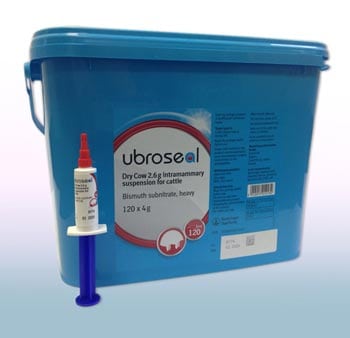27 Jul 2018
The dry period is an opportunity to rid the udder of any infection and prepare it for the coming lactation. Using the appropriate dry cow therapy also protects the udder once lactation has started.

Dairy farmer and veterinary surgeon Victoria Bushby demonstrates her standard drying off procedure using Ubroseal.
A group of seven European experts in bovine mastitis recently published a poster at the National Mastitis Council meeting in Arizona stating that:
“We recommend administering an internal teat sealant (ITS) at drying off, to all cows, on all farms.”
They added that those animals that are likely to be infected need to receive antibiotic dry cow therapy (ADCT) in addition to a teat sealant.
The statement was made following a workshop, hosted by Boehringer Ingelheim, which aimed to:
Despite diverse backgrounds and opinions, the group did reach agreement and the consensus that all cows should receive an ITS at drying off was reached.

Teats remaining open after dry off make the udder highly susceptible to infection and delayed teat closure exacerbates the risk of acquiring an intramammary infection1 post-dry off.
With a 300-cow US study showing that, a week after drying off, 47% of teats had still not formed a keratin plug1 and a New Zealand study showing that one in 20 cows had teats that remained open for 60 days2, it is clear to see that delayed teat closure is a very real problem in many herds.
Further advice was given by the group on what constitutes a high risk and low risk herd.
The following consensus was reached on the definition of a high risk herd:
In addition, the group proposed the following thresholds to indicate that cows are likely to be infected with a major pathogen and therefore should be considered as candidates to be dried off with ADCT in addition to ITS.
The expert group’s statement about routine ITS use coincides with the launch of Ubroseal from Boehringer, the company’s first teat sealant.
Ubroseal features a flexi-cap which has been shown to reduce the risk of teat canal damage and its longer plunger makes application more ergonomic and significantly easier for the farmer.
This autumn Boehringer will be hosting regional workshops for vets, on how to put the consensus on dry cow therapy into practice as part of a comprehensive milk quality service. Details will be circulated locally. A short video on best practice administration of Ubroseal can also be viewed here…
Ubroseal Dry Cow 2.6 g Intramammary Suspension for Cattle contains Bismuth Subnitrate, heavy. UK: POM-V Further information available in the SPC or from Boehringer Ingelheim Ltd, Animal Health, RG12 8YS, UK. Tel: 01344 746960 (sales) or 01344 746957 (technical).
Email: [email protected]. Ubroseal is a registered trademark of Boehringer Ingelheim Vetmedica GmbH, Ingelheim, Germany. ©2018 Boehringer Ingelheim Ltd. All rights reserved. Date of preparation: July 2018. AHD 11138 Use Medicines Responsibly.
Boehringer Ingelheim Animal Health Business Unit
Boehringer Ingelheim is the second largest animal health business in the world. We are committed to creating animal well-being through our large portfolio of advanced, preventive healthcare products and services. With net sales of €3.9 billion and around 10,000 employees worldwide, we are present in more than 150 markets. For more information visit www.boehringer-ingelheim.com/animal-health/overview.